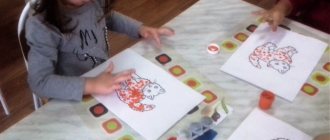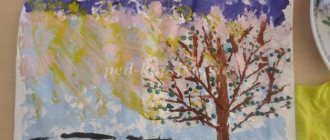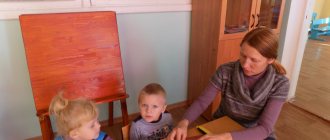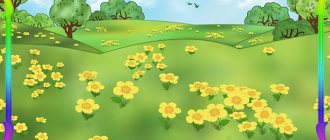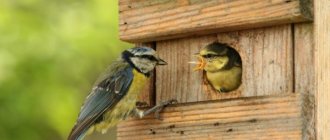Notes on drawing in the second junior group “Flowers for Mom”
Alekseenko Galina Mikhailovna
Notes on drawing in the second junior group “Flowers for Mom”
Educational field: “Artistic and aesthetic development”
Topic: “
Drawing flowers using an unconventional technique” (print with crumpled paper)
.
Introduce children to the upcoming holiday
Master the technique of performing work using the tampon method.
Improve compositional skills in arranging an object in the center of the sheet.
Summary of a lesson on art activities (drawing) in the second junior group “Spring Flowers”
Svetlana Jalilova
Summary of art activities (drawing) in the second junior group “Spring Flowers”
Educator: Jalilova S. Sh
• Introduce children to the technique of unconventional drawing - “ palm drawing ”
• Cause an emotional and aesthetic response to the topic of the lesson .
• Learn to convey the image of spring flowers , structure and shape using the palms of your hands.
• Consolidate knowledge of colors (green, yellow, red, blue)
.
• Foster a caring attitude towards nature.
Material: Whatman paper, yellow, green, blue and red finger gouache, illustrations of tulips, brushes, napkins.
The importance of fine arts for children 3–4 years old
Fine art is the result of artistic and creative activity that reflects the author’s ideas about the world around him. In this sense, the key concept for organizing the educational process in kindergarten is the child’s visual activity, including drawing, modeling and appliqué. Moreover, drawing is the most accessible way for children to express their experiences and emotions. Drawings help the teacher understand a child who does not yet speak at a sufficient level or has difficulties communicating with adults and peers. In the process of creating a drawing, the child learns to compare real objects with his ideas about them. And it is precisely this type of visual activity that can captivate the most restless preschool children.
The goals of drawing classes in a preschool educational institution are:
- acquaintance with applied arts, in particular with works of architecture, painting, and folk crafts;
- developing the ability to comprehensively study an object, noticing and analyzing its color, shape, structure;
- expanding the experience of tactile sensations and observation;
- eye and fine motor skills training
- development of creative abilities and skills in conveying surrounding realities in independently completed works;
- formation of aesthetic ideas about beauty;
- education of artistic taste.
In drawings, children embody their ideas about the world
Objectives of drawing classes in the second junior group
To achieve the goals set in visual arts lessons, the teacher solves the following tasks:
- teach techniques for displaying straight and round lines on a plane - paths, paths, balls, etc. (this skill is key for the further accumulation of techniques for depicting objects - wavy lines, zigzag, etc.);
- introduce the principle of decomposing an image into several parts that have geometric shapes (for example, a tumbler is made of circles, the sun is made of a circle and straight lines);
- learn to convey rectangular objects in a drawing that require changing the direction of hand movement and forming an angle, closing lines at one point (for example, books, windows, flags, etc.);
- practice the skill of correctly gripping a pencil (with three fingers) and basic actions with a brush (pick up paint, remove excess paint on the edge of a glass, rinse the brush, follow the direction of the brush along the sheet - make strokes in one direction, move the brush along the pile);
- to cultivate a sense of harmonious transmission of shades (children evaluate color combinations to their taste, giving ratings “beautiful”/“not beautiful”);
- develop spatial thinking and train the skill of placing the composition of a drawing in the center of the sheet;
- learn to draw straight and intersecting lines, outlines of objects of elementary geometric shapes;
- develop the ability to listen carefully to the teacher’s instructions, focus on clarity when performing a drawing, and also follow the agreed sequence of actions;
- stimulate interest in drawing.
Drawing materials
In order for the process of introducing visual creativity to be interesting and productive, it is important to choose the right materials.
The basis
The most suitable substrate would be sheets of white A4 paper. However, this does not exclude the option of using sheets of colored paper for the printer, because it is more interesting to draw the sun on a blue “sky” background, and snow on a dark, almost purple, that is, on a sheet of the corresponding shade. It should be taken into account that the paper must be thick enough, because the baby initially moves the brush so intensively over the surface that it rubs the sheet to holes. Therefore, if the topic involves densely filling the sheet with the composition of the drawing (for example, in the task “Trees on our site”), then it is better to generally use thin cardboard.
If the drawing is done with pencils, then the size of the sheet may be smaller, since to create an image you need to perform monotonous movements repeatedly, and performing these manipulations on a large format tires children.
Paints, brushes, pencils
In the second younger group, children draw more with gouache, which produces bright and rich tones, and the teacher necessarily tints the colors, obtaining the most suitable shades, the brightness of which, in turn, acts as an additional incentive for children to comprehend the basics of fine art. In addition, gouache, unlike watercolor, does not need to be diluted with water.
For children 3–4 years old, a set of six colors would be optimal - with more shades, it is more difficult for children to decide on the right ones.
The most convenient brush option for beginning artists is a squirrel brush with a short handle (nos. 10–14).
During the work, the teacher constantly emphasizes the correct grip of the brush (pencil, felt-tip pen): hold the pencil by the middle with three fingers. This position resembles the beak of a bird.
Pencils should be soft and of good quality so that they do not crumble. As for the number of flowers, there can be 6–8. It is difficult for kids to hold thin, so-called standard, pencils in their fingers, so it makes sense to take thicker ones.
The kids have been familiar with pencils since last year; it was with them that the young artists made the first lines on a sheet of paper, using 1-2 colors for this.
Additional materials
Despite the initial level of mastery of fine arts, children already in the second junior group become familiar with various non-traditional drawing techniques. Therefore, you cannot do without additional materials. The most popular are:
- cotton swabs, small balloons (for applying paint);
- autumn leaves (for creating prints and for decoration);
Drawings with leaf prints help create beautiful backgrounds for autumn pictures.
Summary of a lesson on non-traditional drawing in the second junior group “Spring Flowers”
Zeinib Chenib
Summary of a lesson on non-traditional drawing in the second junior group “Spring Flowers”
MBDOU Kindergarten No. 5 “Kalinka”
p Enem Republic of Adygea
teacher of the highest categories Chenib Zeinib.
Summary of a lesson on non-traditional drawing in the second junior group “ Spring Flowers ”
Goal: Introducing children to an unconventional drawing technique (printing with crumpled paper)
.
— Formation and development of artistic and creative abilities.
— Show children the possibility of obtaining an image using a print of crumpled paper.
— Activate children’s speech, improve their ability to listen and hear the teacher, and understand speech.
— Develop fine motor skills of the hands.

